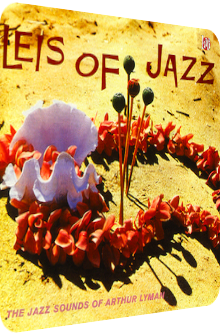
Arthur Lyman
Leis Of Jazz
1957
When an artist or group delivers a lackluster and alienating album, this needn’t be interpreted as a disaster or utter disappointment in each and every case, for such works only drive you back to the much beloved preceding offerings that sparkle all the more in contrast to the unwanted change of formula. Such is the case with Arthur Lyman's Leis Of Jazz, an album of eleven renditions of Jazz classics and one unique composition.
Released in 1957 as the band's first proper album, it is comprising of pianist and backing mallet instrumentalist Alan Soares, bassist and flutist John Kramer, percussionist Harold Chang as well as vibraphone legend Arthur Lyman; it tries to cater to a different audience, mainly sophisticated Jazz lovers who came to love the Martin Denny Group due to their exotic renditions of classics, of which Lyman was part of. While the vibraphone still plays an important role in all of the compositions, the various birdcalls and exotic percussion are unfortunately amiss. It is as if the band wanted to break free from their reduction to an Exotica quartet, showing that they can cope with sudden changes of rhythmic patterns and spiraling melodies. Since the band was just formed in 1957, this is probably less of a problem. However, Arthur Lyman himself was in the limelight back then, and known for his birdcall talent – their omission is thus all the more pitiful. Let's see if there are some dreamy interludes in there with a scent of vintage Exotica in addition, and whether this album has its merits and charming inclusions. In short: yes, it has. But less so than any other Lyman album of the 50's.
Launching the album off tastefully with a rapid-firing version of The Lady Is A Tramp, Kramer's quick double-bass base frame holds together Soares' sunny piano chords, Lyman's exuberant performance on the vibes as well as Chang's silky shakers. The bridges seem to be improvised and quite far off, but this is actually the big strength of this rendition. It isn't overly exotic, but a great counterpoint to the gazillion big band takes. On The Street Where You Live by Alan Jay Lerner and Frederick Loewe is next, presented in a 6/8 rhythm here that morphs into a military march, with deliciously hollow wood blocks, a strong focus on convivial piano tones and vibraphone accompaniments by Lyman. The melodies are vivid, the constant rhythm changes jumpy and demanding, yet not all too convoluted. A nice upbeat song with a glimpse of Exotica.
Leis Of Jazz is the unique composition by Lyman, and it's a swinging, upbeat skit with glistening, frantic vibraphones, double bass shuffles and warm piano accompaniments. Curiously enough, this is a Jazz song by the numbers. One would have guessed that Lyman did rev up the title track with a few birdcalls or exotic percussion, but no, even though it is 1959 when this album is released, the group shies away from connecting this work to their exotic oeuvre. The Way You Look Tonight, originally performed by Dorothy Fields, is another exhilarative Jazz track with a great motif of staccato pianos that spiral up and down. The middle section consists of quick vibraphone notes and a rather rustic piano-related jumpiness.
While the almost five minutes long How High The Moon is a much-needed romantic song with a slow beat, gorgeous xylophone droplets and humble percussive backings, the latter of which morph into a tremendously quick rhythm that stands in great contrast to the phantasmagoric beginning and tends to destroy the carefully built up mood, Trigger Alpert's Trigger Fantasy lets the instruments shine on their own due to the lack of any piercing percussion: eclectic piano sprinkles cause a reaction of the nocturnal vibraphone drops that are placed throughout the song. I like the purposeful reduction and the interplay between sound, sustain and space that makes up the majority of the rendition. But again, you won't find the realms of Exotica in here.
Side B begins with Joe Young's perniciously titled Lullaby Of The Leaves, and it is as great a start of side B as The Lady Is A Tramp was on side A. The vocals of Ethel Azama are featured for a short moment, making this Arthur Lyman's first vocal track that is featured on an album with him as the front man! The groove is laid back, the piano backings dreamy whereas the vibraphone sections underline the main attraction of this interpretation, namely Mrs. Petkere's vocals. An unsuspected change of formula.
While Body And Soul accomplishes a successful fusion of Jazz and Exotica due to the reverie-driven euphony of Lyman's vibraphone chords and the tremendously mellow piano backings plus the melting percussion with further surprises such as rhythmic changes and Far Eastern tonalities attached to this song, Lorenz Hart's and Richard Rodger's My Funny Valentine would be a gorgeous Exotica track due to its dreaminess and the mysterious vibraphone sweeps that wash over the enchanted listener, were it not for the melodramatic piano backings that push this interpretation firmly into the realms of unexciting Jazz numbers. It's a real bummer, for this track has it all, but it is destroyed in the end by Soares' dusky piano notes. But to say it positively: we were almost there in the realms of Exotica!
Gypsy In My Soul is a bland Jazz offering that is far away from Polynesian lands. Those lands are all of a sudden near and glaringly perceptible with the inclusion of a fantastic take of Aloa Oe: launching with thunderous drums whose sustain reverberates heavily and creates a much-needed feeling of wideness, the song morphs into a graceful downbeat that is nurtured by punchy vibraphones, slightly wonky piano backings and fizzling maracas. For the umpteenth time, a rhythmic change takes place, reducing the solemnity, but leading to another superb percussion section which finishes the song and leads to the final Lullaby Of Birdland. It is here that the bold Jazz flavor returns with exhilarative vibraphone-xylophone drops and vibrant percussion. The sustain of the vibraphone fades out, bringing back the dreamy gleam that I love so much about Lyman's music for about five seconds. Unfortunately, the song doesn't have anything else to offer, hence ending the album on a weak note, I'm afraid.
It's hard to determine the quality of Leis Of Jazz, given the admittedly narrow scope of AmbientExotica. The album is a prime example for the case of an exotic instrument such as the vibraphone that can suddenly lose all of its dreamy traits, now sounding less vibrant and colorful in jazzy surroundings. I won't slate or mock Lyman's work just because it isn't exotic enough for my taste, but I am more than a bit bewildered about the choice of the album title which suggests a highly attractive fusion of Exotica (the titular Leis) with Jazz. Unfortunately, the album falls short in this regard.
No birdcalls and only the faintest glints of mellifluous sustains in ever-changing rhythmic patterns make this an upbeat, not too complex album. I can't get my head around the notion that this album was released in 1957, both at the rise of the Exotica genre and before all the multicolored album gems delivered by the Arthur Lyman Group. It is as if the band really wants to take a stand, showing fans and sophisticated Jazz afficionados alike that either Exotica is more than the sum of its parts or the opposite, meaning that the band doesn't want to be reduced time and again to the tropical glitz and Polynesian jungles. The band wasn't known for their Exotica style yet, but Lyman himself sure was back then!
The essence of my introductory sentence still stands at the end of my review as well: this album lets me love the exotic works of Arthur Lyman all the more, and while I don't consider Leis Of Jazz a misstep per se, its appeal for Exotica fans is definitely less sparkling. It's the only Lyman album of the 50's that I don't recommend as a whole. I really tried, but the thought of Arthur Lyman spending his energy on common Jazz arrangements rather than spicing all of these themes with bamboo rods, temple gongs and rainsticks and is hence – in an oxymoronic twist – avoiding clichés by attaching kitsch, makes me uncomfortable and lets me turn my head to the many exotic records by the band. 1959 when Leis Of Jazz was re-issued for the first time, luckily, had many an exotic Lyman record to offer, among them the vivid Bahia, the solemn Hawaiian Sunset and the very first – if slightly flawed – exotic concept album called The Legend Of Pele. These are definitely the better choices.
Exotica Review 092: Arthur Lyman – Leis Of Jazz (1959). Originally published on Jul. 14, 2012 at AmbientExotica.com.
